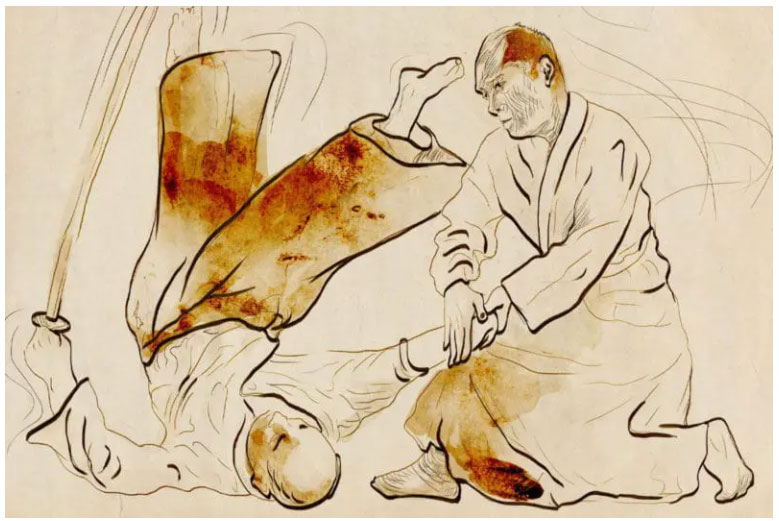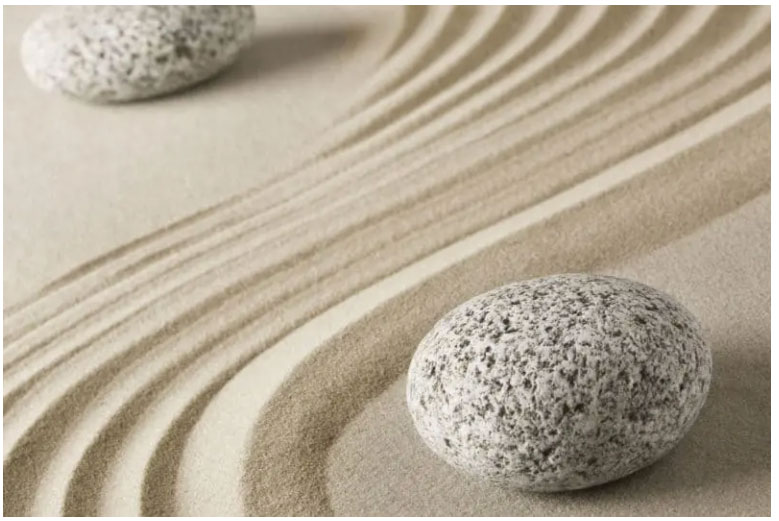Chi meaning
What is Chi, sometimes transcribed as "Qi", this Asian notion that we hear more and more about in the West? It is not easy to give Chi a clear and restricted definition, as the notion of Chi touches on various fields of application and is not translatable without being forced to scratch the full and original meaning of the word. Indeed, the word "Chi" has no precise equivalent in French. One hears Chi referred to as a vital energy, but here again, the term energy is only an attempt at translation on the part of Westerners. Sticking to Chinese texts, it would be more correct to speak of essence or breath. Namely: Chi is a Chinese word and concept, but also appropriated by the Japanese who have an equivalent concept, Ki.
So, Chi, what is it?
It is a hypothetical notion coming from Chinese and Japanese cultures, which designates an imperceptible fluid that creates, forms and animates the universe and all life forms. Chi evolves on three levels: the structure of the universe, living beings and spirituality (in the sense of the elevation of the spirit). There is therefore a spiritual approach to Chi, developed by Taoist philosophy, defining Chi as a breath circulating in the universe, being both the source of life and what allows it to be perpetrated.
The Chi would also circulate inside the body, in invisible channels called meridians. What we know about it in the West is essentially its applications in the field of acupuncture, but traditional Chinese medicine has many uses for it.
Becoming aware of the circulation of the Chi in nature and in one's own body would make it possible to successfully exploit it, and thus to heal a sick body in its medical applications, or to increase tenfold the power of a fighter's body in the martial arts.
If your curiosity is piqued, here is all you need to know about Chi.
Chi in Chinese cosmogony
As we have previously explained in a few words, one of the planes on which Chi evolves is the structure of the universe. This is a unique fundamental principle, described as such in Chinese cosmogony, i.e. the traditional theory that explains the formation of the universe. According to this theory, therefore, it is from the creative breath that the universe derives its structure and it is through it that beings are animated.
How to imagine the Chi?
We must imagine the Chi as a fluid that circulates freely, regularly and indifferently between all things and beings of the universe, animated or not, as a quiet force that is omnipresent, that creates, that preserves and that makes evolve. It thus acts on the universe like a binder: everything that composes it is permanently connected: mineral, vegetable, body, the inert, the mobile, the living or not...
Where the monotheistic religions consider that a God pre-existed the universe and is its creative force, in Chinese cosmogony, it is the Chi that occupies this function. Beware, however, Chi is never thought of as a deity!
Ying and Yang are at the origin of
The notion of Chi as a fundamental principle of Chinese cosmogony is intimately linked to the notion of Ying and Yang, wrongly taken up by Westerners who are so familiar with this symbol where black and white ally. In reality, in the Chinese tradition, at the beginning of the universe, Chi existed in an undifferentiated form, the first and only one, the wuji. This wuji is then polarized into a Ying pole and a Yang pole, to found the Tàiji, the "supreme ridge beam" of the cosmos, the key element in the structure of the universe. From this Tàiji arise all the combinations of Ying and Yang at the origin of all things and all beings making up the universe. Ying and Yang are thus two antagonistic elements that complement and interpenetrate each other, and it is through this constantly evolving matter that Chi is expressed.
Chi is interpreted by five fundamental movements, which could be designated as five elements: water, fire, earth, wood and metal. The breath of the Chi, cyclic, regular, coherent, is represented in the matter by these elements.

Chi in Taoist philosophy: the Qi gong.
Chi has an important place in Taoist philosophy and spirituality. It participates in the elevation of the spirit of a being. By practicing meditation in the manner of the Taoists, becoming aware of Chi and succeeding in using it would allow the practitioner to reach more effectively the state of mental elevation supposed to join the original functioning of the cosmos. We then speak of a return to wuji (remember, this original matter which is composed of Chi). This practice, this meditation, is called qi gong, and is based on breathing exercises, mental visualizations, movements, postures... All these exercises have the benefit of stimulating the Chi which, we will come back to this later, circulates in the body according to a precise topography.
During the practice of qi gong, the breath of Chi passes through three points, called refining centers, which are located at precise places on the human body, the dantian :
The lower dantian
First there is the lower dantian, located below the navel. This is the place where Chi as a vital substance comes from, and where it must be maintained by the meditator. It is in a way the Chi factory of the human body.
The Intermediate Dantian
The second point, the intermediate dantian, is located at the sternum, very close to the heart. It is the place where the Chi transforms into Shen, a more subtle form of breath and proper to the thought. This is where the first stage of Chi refinement takes place.
The Upper Dantian
Finally, the third point, the superior dantian, is located in the head, where the Shén is transformed into a breath of spirituality, this famous state of unity with the cosmos sought by the Taoist meditator, which would be able to bring it to a state of equilibrium and to act in conformity with the laws of the universe. In the higher Dantian, Chi reaches its most refined form.

The circulation of Chi
If we believe what we have just explained about the practice of Qi gong, we understand that Chi is perceived as a fluid that circulates in the human body, even if science has never validated the existence of such a fluid, which has only been defined empirically, and we will come back to this in the context of Chinese medicine. For the moment we are interested in the circulation of Chi as a simple empirical theory.
The Chi circulates in the body through invisible channels, such as metaphysical veins, called meridians. These meridians form in the body a network of circulation of the Chi. Some of these meridians are primary and others are secondary. In addition to the meridians, we also speak of points of concentration of the Chi in areas where the meridians intersect, for example, or sometimes outside the meridian network.
Through centuries of practice and theory, the topography of the meridians and points in the body has not changed at all. The diagram that is still valid today was drawn by the physician Li Shizhen in the 16th century, and it is still according to this diagram that acupuncture is practiced. Li Shizhen established 12 so-called "ordinary" meridians and 8 so-called "extraordinary" or "curious" meridians. They connect a total of 361 acupuncture points.
Apart from these classical internal meridians, there are other meridians that connect skin, muscles and organs, but the pattern of these, unlike the classical meridians, varies over time and according to different medical schools. This requires further research for those interested in the topography of the meridians.
Chi and Traditional Chinese Medicine
Since Chi circulates freely in the human body and can be stimulated to be exploited, it is obvious that it has applications in medicine. Traditional Chinese medicine is based in many areas on the circulation of the Chi, the meridians and the points of concentration of the Chi. But in order to understand how a concept that may seem so abstract can be exploited in medicine, one must first understand the empiricism on which the theory is based, i.e. by what effects, by what experiences the existence of such a fluid has been demonstrated by Chinese medicine.
In traditional Chinese medicine, it is considered to be related to brain activity and thought. The Chi, as it circulates in the body, would in fact be perceptible in the form of various very subtle sensations: heat, tingling... By concentrating, meditating, practicing a kind of introspection of one's own body, one would be able to feel these symptoms, and thus become aware of the Chi. This is how the maps of the traffic network were established!
When one becomes aware of this network and stimulates the circulation or areas of Chi concentration, other more important symptoms appear which are measured and interpreted. Heart rate may vary, blood pressure may increase or decrease, body temperature may rise or fall. Sweating, muscles, resistance to pain, etc. are also observed.
There are 2 kinds of Chi
In Chinese medicine, there are two kinds of Chi, or at least two ways of interpreting and treating Chi: the integral breath, or zhengqi, is the positive breath of Chi, the one that guarantees good health and must be stimulated to strengthen the body. The vitiated breath, the xieqi, is on the contrary the breath at the origin of diseases. The aim of Chinese medicine is of course to restore a healthy balance in the human body by stimulating the clean breath and annihilating the vitiated breath.
Contrary to what we often hear, Chinese medicine is not a simple ancestral tradition based on spiritual beliefs or legends. In fact, clinical research about Chi is being conducted in China, particularly at the Institute of Traditional Medicine in Chongqing and the Institute of Physics and High Energies in Beijing. Traditional Chinese medicine, as you will have understood, is largely based on the theory of Chi. Like blood, which is a visible material fluid, Chi is considered a body fluid.
Chi in Medicine Today
In practice, the notion of Chi is at the origin of techniques such as acupuncture, which consists of applying pressure with needles on areas of Chi concentration to stimulate it, but also of specific massages based on the circulation of Chi in the meridians. Theories of dietetics are also based on him, since diet supposedly has a direct influence on the circulation of the Chi.
In Japan, we also find shiatsu, a technique of massages and physical exercises, including breathing exercises, which resembles Qi gong, and whose aim is to stimulate the Ki.

Chi in martial arts
Since it is beneficial for the human body and has the property to strengthen it, it also finds its application in the Asian fighting arts, martial arts.
Concerning the Chinese martial arts, they all use the notion of Chi, but when some will rather use the control of the circulation and the manipulation of the breath, others will insist more on the muscular reinforcement. The taiji quan, for example, aims to divert the chi of the fighter to send it back to his opponent. It is based on a breathing technique aimed at stimulating the lower dantian. The breathing to be adopted is based on an imitation of the breathing of infants, who breathe with the belly: in this way the breath is deeper and allows to make more effective efforts, longer. Shaolin kung-fu is based on the targeting of precise points on the opponent's body in order to weaken it and make the attacks more effective.
Chi in Japanese martial arts
The Japanese belief in Ki is slightly different from the Chinese and their Chi. In Japanese martial arts, it is considered that when a fighter strikes a blow to his opponent, he transmits his Ki and that this is what causes the injuries. The goal is therefore to hit vital points, the points where the meridians meet. The Ki must be externalized by the fighter. This is the reason why the blows are sometimes accompanied by a cry, especially in karate.
We now know that it is supposed to link together the beings and things of the universe. Well, for the Japanese, this also means that two opposing fighters are connected by Ki. It is on this premise that aikido is based, which aims at uniting the energies of the combatants who become partners: there is no more aggression, it is teamwork.
We also find the concept of Ki in the ninja arts, ninjutsu. The principle is to use Ki common to all to sense the intention of the enemy: this is what the Japanese call vigilance, zanshin.

The notion of Chi is a very complex notion, which touches many areas of Asian culture and daily life. If the concept is originally Chinese, it exists under different names in other Asian countries, such as Japanese Ki, and is an essential part of what makes this part of the world so attractive to Westerners, who are trying more than ever to understand and appropriate it. What if this age-old belief finally represents the future of medicine?


